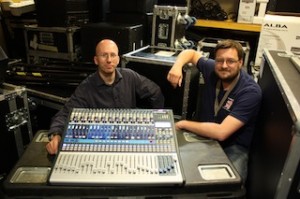StudioLive Comes to Liverpool Institute for Performing Arts
 Liverpool, UK – June 2013…. Since opening its doors in 1996, Liverpool Institute for Performing Arts (LIPA) has become one of the leading performing arts schools in the UK, if not the world. Founded by Mark Featherstone-Witty and Sir Paul McCartney, the school emphasizes a multifaceted and holistic approach to training in the arts.
Liverpool, UK – June 2013…. Since opening its doors in 1996, Liverpool Institute for Performing Arts (LIPA) has become one of the leading performing arts schools in the UK, if not the world. Founded by Mark Featherstone-Witty and Sir Paul McCartney, the school emphasizes a multifaceted and holistic approach to training in the arts.
“Our view is that every student should attain some knowledge of all the individual disciplines that make a performance possible,” explains Jon Thornton, Director of LIPA’s School of Sound Technology. “While they study their chosen major in depth, including management, stage design, lighting, and sound engineering, they also have to develop a working vocabulary in each of these areas.”
This integrated approach does much to prepare LIPA students for real-world situations, says Thornton. “We create an environment that’s as professional as possible. It’s all about interdisciplinary collaboration; it’s as important for a sound engineer to understand what it’s like to stand on stage as it is for an actor or musician to understand what it is like to mix at front of house.”
The school is well equipped with several tracking and mixdown rooms, and it recently added a StudioLive™ 24.4.2 digital console to its arsenal. “We’ve got a fair amount of studio equipment, and a fair amount of live sound equipment,” Thornton says. “But the StudioLive filled a perfect niche for us. First, it gave us something with a small footprint, which was great for lectures and events where a large desk is overkill. But more importantly, it blows away the boundary between a live desk and a recording console. The way you can quickly and easily plug in a laptop and capture multitrack audio for all kinds of gigs is great for us.”
The school has a number of high-end recording rooms but Thornton says the StudioLive fills a different role. “We’ve got six studios with consoles ranging from SSLs to Icons,” he observes. “But if a musician or an engineer says ‘we don’t want to sit in a studio, we want to track in, say, this vibe-y church we found somewhere,’ it’s really, really easy to just take the StudioLive and a small laptop rig to do tracking almost anywhere.”
For live performance, the console is equally useful. “We do a lot of one-off shows: intimate cantina gigs for around 100 people. The StudioLive is perfect for those, and we’re now able to record every gig. And we’ll be taking it along for a ten-day music festival we’ve got coming up as well.”
“The user interface on the StudioLive is great,” Thornton adds. “It’s a very intuitive, visual and tactile approach, with hands-on faders and a simple workflow that’s easy for students to grasp. And the Capture application is clean and simple and doesn’t get in the way of the spontaneity of the live mixing process.”
Thornton concludes, “the StudioLive may not be the solution for everything we do, but it’s a great solution for a lot of things we weren’t able to do easily before.”


